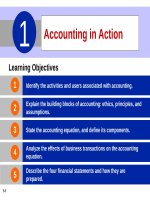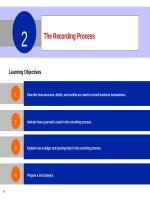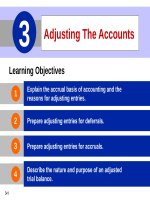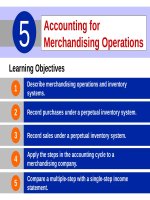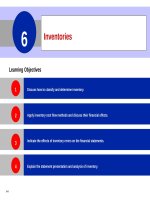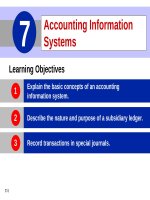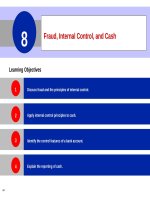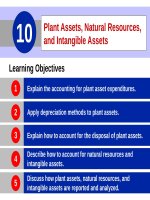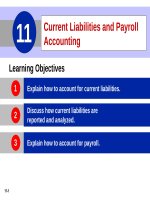Accounting principles 10e by kieso chapter 01
Bạn đang xem bản rút gọn của tài liệu. Xem và tải ngay bản đầy đủ của tài liệu tại đây (1.7 MB, 56 trang )
1-1
CHAPTER1
Accounting in
Action
1-2
PreviewofCHAPTER1
1-3
What is Accounting?
Purpose of accounting is to:
1. identify, record, and communicate the economic
events of an
2. organization to
3. interested users.
1-4
SO 1 Explain what accounting is.
What is Accounting?
Three Activities
Illustration 1-1
Accounting process
The accounting process includes
the bookkeeping function.
1-5
SO 1 Explain what accounting is.
Who Uses Accounting Data
Internal Users
Human
Resources
Finance
Management
IRS
Investors
There are two broad
groups of users of
financial information:
internal users and
external users.
Marketing
Customers
1-6
SEC
Labor
Unions
Creditors
External
Users
SO 2 Identify the users and uses of accounting.
Who Uses Accounting Data
Common Questions Asked
User
1. Can we afford to give our
employees a pay raise?
Human Resources
2. Did the company earn a
satisfactory income?
Investors
3. Do we need to borrow in the
near future?
Management
4. Is cash sufficient to pay
dividends to the stockholders?
Finance
5. What price for our product will
maximize net income?
Marketing
6. Will the company be able to
pay its short-term debts?
Creditors
1-7
SO 2
1-8
The Building Blocks of Accounting
Ethics In Financial Reporting
Standards of conduct by which one’s actions are judged as
right or wrong, honest or dishonest, fair or not fair, are
Ethics.
1-9
Recent financial scandals include: Enron, WorldCom,
HealthSouth, AIG, and others.
Congress passed Sarbanes-Oxley Act of 2002.
Effective financial reporting depends on sound ethical
behavior.
SO 3 Understand why ethics is a fundamental business concept.
Ethics in Financial Reporting
Question
Ethics are the standards of conduct by which one's
actions are judged as:
a. right or wrong.
b. honest or dishonest.
c. fair or not fair.
d. all of these options.
1-10
SO 3 Understand why ethics is a fundamental business concept.
1-11
Generally Accepted Accounting Principles
Financial Statements
Various users
need financial
information
Balance Sheet
Income Statement
Statement of Owner’s Equity
Statement of Cash Flows
Note Disclosure
The accounting profession
has attempted to develop a
set of standards that are
generally accepted and
universally practiced.
1-12
Generally Accepted
Accounting
Principles (GAAP)
SO 4 Explain generally accepted accounting principles.
Generally Accepted Accounting Principles
Generally Accepted Accounting Principles (GAAP) - A set of
rules and practices, having substantial authoritative support, that
the accounting profession recognizes as a general guide for
financial reporting purposes.
Standard-setting bodies determine these guidelines:
1-13
►
Securities and Exchange Commission (SEC)
►
Financial Accounting Standards Board (FASB)
►
International Accounting Standards Board (IASB)
SO 4 Explain generally accepted accounting principles.
Generally Accepted Accounting Principles
Measurement Principles
Cost Principle – Or historical cost principle, dictates that
companies record assets at their cost.
Fair Value Principle – Indicates that assets and liabilities
should be reported at fair value (the price received to sell an
asset or settle a liability).
1-14
SO 4 Explain generally accepted accounting principles.
1-15
Generally Accepted Accounting Principles
Assumptions
Monetary Unit – include in the accounting records only
transaction data that can be expressed in terms of money.
Economic Entity – requires that activities of the entity be
kept separate and distinct from the activities of its owner and
all other economic entities.
1-16
Proprietorship.
Partnership.
Corporation.
Forms of Business
Ownership
SO 5 Explain the monetary unit assumption
and the economic entity assumption.
Forms of Business Ownership
Proprietorship
Generally owned
by one person.
Owned by two or
more persons.
Often small
service-type
businesses
Often retail and
service-type
businesses
Owner receives
any profits,
suffers any
losses, and is
personally liable
for all debts.
1-17
Partnership
Generally
unlimited
personal liability
Corporation
Ownership
divided into
shares of stock
Separate legal
entity organized
under state
corporation law
Limited liability
Partnership
agreement
SO 5 Explain the monetary unit assumption
and the economic entity assumption.
Generally Accepted Accounting Principles
Question
Combining the activities of Kellogg and General Mills
would violate the
a. cost principle.
b. economic entity assumption.
c. monetary unit assumption.
d. ethics principle.
1-18
SO 5 Explain the monetary unit assumption
and the economic entity assumption.
Generally Accepted Accounting Principles
Question
A business organized as a separate legal entity under state
law having ownership divided into shares of stock is a
a. proprietorship.
b. partnership.
c. corporation.
d. sole proprietorship.
1-19
SO 5 Explain the monetary unit assumption
and the economic entity assumption.
The Basic Accounting Equation
Assets
=
Liabilities
+
Owner’s
Equity
Provides the underlying framework for recording and
summarizing economic events.
Assets are claimed by either creditors or owners.
Claims of creditors must be paid before ownership claims.
1-20
SO 6 State the accounting equation, and define its components.
The Basic Accounting Equation
Assets
Resources a business owns.
Provide future services or benefits.
Cash, Supplies, Equipment, etc.
Assets
1-21
=
Liabilities
+
Owner’s
Equity
SO 6 State the accounting equation, and define its components.
The Basic Accounting Equation
Liabilities
Claims against assets (debts and obligations).
Creditors - party to whom money is owed.
Accounts payable, Notes payable, etc.
Assets
1-22
=
Liabilities
+
Owner’s
Equity
SO 6 State the accounting equation, and define its components.
The Basic Accounting Equation
Owner’s Equity
Ownership claim on total assets.
Referred to as residual equity.
Investment by owners and revenues (+)
Drawings and expenses (-).
Assets
1-23
=
Liabilities
+
Owner’s
Equity
SO 6 State the accounting equation, and define its components.
Owner’s Equity
Illustration 1-6
Revenues result from business activities entered into for the
purpose of earning income.
Common sources of revenue are: sales, fees, services,
commissions, interest, dividends, royalties, and rent.
1-24
SO 6 State the accounting equation, and define its components.
Owner’s Equity
Illustration 1-6
Expenses are the cost of assets consumed or services used in
the process of earning revenue.
Common expenses are: salaries expense, rent expense,
utilities expense, tax expense, etc.
1-25
SO 6 State the accounting equation, and define its components.

